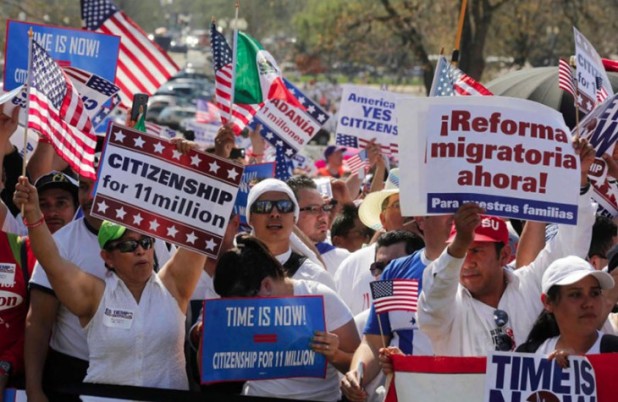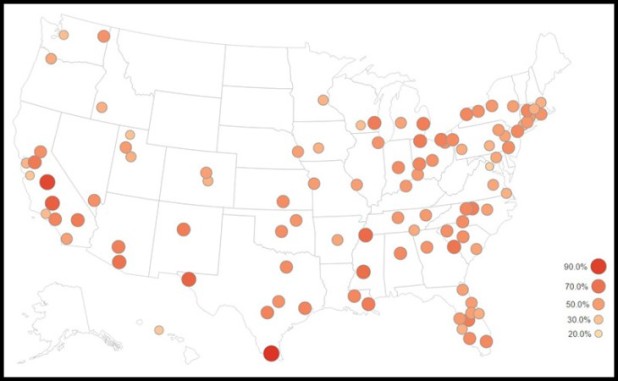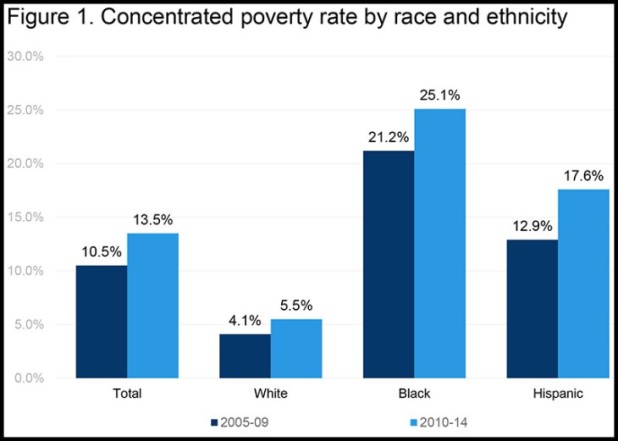The New Observer
April 5, 2016
“Extreme poverty” levels within the US have rocketed by over 100 percent during the last fifteen years, directly paralleling the speeded-up nonwhite invasion—and conclusively disproving the argument that “immigration would bring economic growth.”
According to a new report by the Brookings Institution’s Metropolitan Policy Program, some 14 million US residents live in extremely poor neighborhoods—more than twice as many as in 2000.
The report, prepared by Brookings Institute fellow Elizabeth Kneebone, does not dare address the cause of the dramatically increased poverty levels, although the conclusions are obvious from the data presented.
Using data from the American Community Survey from 2005–09 and 2010–14, the study found that between 2000 and 2005–09, the number of extremely poor neighborhoods grew by almost 40 percent, and the number of people living in those neighborhoods rose by one-third.
By 2010–14, almost 14 million people lived in neighborhoods with poverty rates of 40 percent or more—more than twice as many as in 2000.
“These challenges disproportionately fall to people of color, and, while they have long been particularly pronounced in inner cities, as poverty has spread beyond the urban core, so too has concentrated disadvantage,” the study says.
For example, between 2005–09 and 2010–14, the share of poor residents living in “distressed neighborhoods” climbed by 4.7 percentage points for Hispanics and 3.9 percentage points for blacks, compared to a much more modest increase of 1.4 percentage points for whites.
Share of the poor population living in a neighborhood with a 20%+ poverty rate.
By 2010–14, poor Hispanics were more than three times as likely as poor whites, and poor blacks were almost five times as likely as poor whites, to live in an extremely poor neighborhood.
Although whites made up 44 percent of the nation’s poor population in that time period, they accounted for just 18 percent of poor residents living in extremely poor neighborhoods.
“High levels of neighborhood distress thus remain a much more prominent feature in the lives of poor blacks and Hispanics than for their white counterparts,” the report says.
The nation’s one hundred largest metro areas are home to more than 70 percent of all poor individuals living in extremely poor neighborhoods. The study then goes on to name some of the worst such areas—and all of them are majority nonwhite.
El Paso, Texas, for example, contained some of the greatest concentrations of poverty in 2010–14, while in McAllen, Texas, some 52 percent of the poor population lived in extremely poor neighborhoods.
These are the regions most heavily overrun with the Latin American “immigrants” who were supposed to be the “new drivers” of the economy and who were supposed to bring such prosperity to the US, at least according to the liberal arguments in favor of Third World immigration.
By 2010–14, the study says, eight metro areas registered concentrated poverty rates above 30 percent, and “considerable numbers of metro areas exhibited high rates of concentrated poverty among black and Latino residents.”
In seventeen metro areas, more than 30 percent of poor Latino residents lived in concentrated poverty, with rates reaching well above 40 percent in metro areas like Buffalo, Fresno, Rochester, and Syracuse.
Syracuse, NY, also led the list for the concentrated poverty rate among black residents, with nearly 59 percent of poor black residents living in extremely poor neighborhoods in 2010–14.
Nearly one-third of the nation’s largest metro areas had more than 30 percent of their poor black residents living in concentrated poverty, and in five regions, more than half of poor blacks lived in extremely poor neighborhoods.
By 2010–14, 26 percent of the urban poor—or 3.3 million people—lived in an extremely poor neighborhood.
The shares reached even higher for poor black residents in big cities (36.3 percent), who lived in concentrated poverty at more than two and a half times the rate of poor white residents (13.4 percent).
The gap between white and black concentrated poverty rates was even more pronounced in suburbs than in cities.
Poor black residents of suburbs were more than three and a half times as likely to live in extremely poor neighborhoods as poor whites in suburbs.
The share of poor black and Hispanic suburban residents living in neighborhoods with poverty rates of at least 20 percent climbed by more than 10 percentage points between 2005–09 and 2010–14.
While poor white residents in the suburbs experienced an uptick of almost 8 percentage points in concentrated disadvantage in that period, just one in four lived in high poverty or extremely poor neighborhoods in 2010–14.
Poor black and Hispanic residents experienced concentrated disadvantage at more than twice that rate.
Tracking the national average, more than half of poor black and Hispanic residents in the suburbs lived in a neighborhood with a poverty rate of at least 20 percent.
This downward economic spiral has mirrored the influx of Third World immigrants—from Latin America and, in areas such as Minnesota and elsewhere—from Africa. It also corresponds directly with the resultant ever-decreasing percentage of whites making up the US population.
The conclusions are obvious:
– Instead of “building the economy” as pro-immigration politicians have claimed, Third World immigration has in fact merely transported the poverty endemic in the Third World into the US, and
– Unless halted and reversed, this process will inevitably lead to America being turned into a majority Third World nation.
 Daily Stormer The Most Censored Publication in History
Daily Stormer The Most Censored Publication in History






